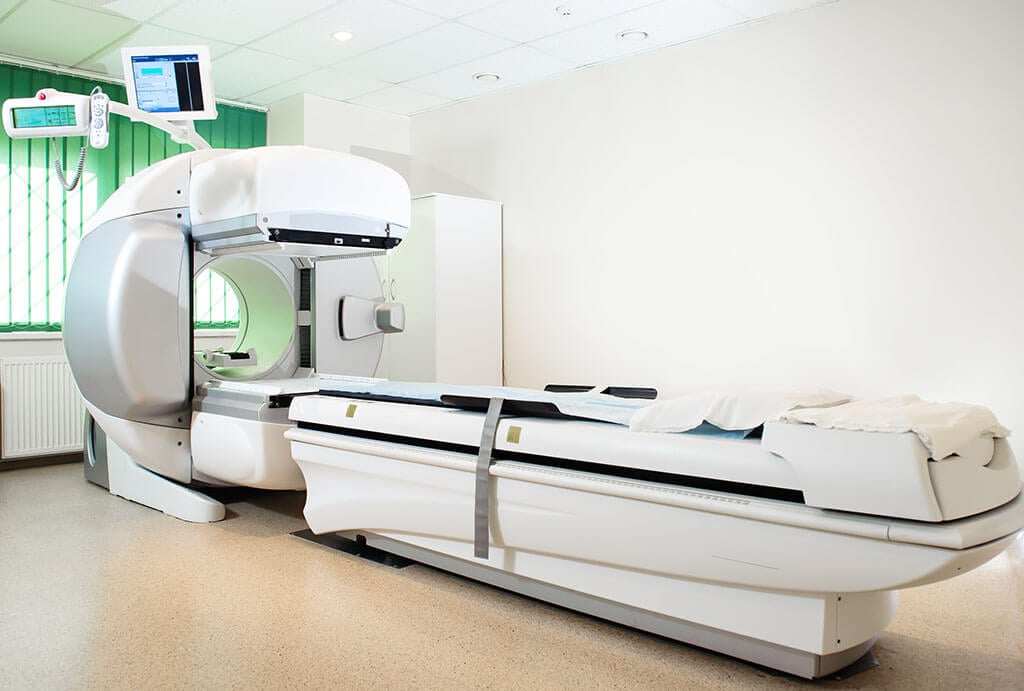
The program includes:
- Initial presentation in the clinic
- clinical history taking
- physical examination
- review of medical records
- laboratory tests:
- complete blood count
- general urine analysis
- biochemical analysis of blood
- TSH-basal, fT3, fT4
- indicators of inflammation (CRP, ESR)
- indicators blood coagulation
- abdominal ultrasound
- CT/MRI abdomen
- preoperative care
- mesh implantation
- symptomatic treatment
- control examinations
- the cost of essential medicines and materials
- nursing services
- nutrition recommendations
- full hospital accommodation
- explanation of future recommendations
Service
You may also book:
 BookingHealth Price from:
BookingHealth Price from:
About the department
According to the Focus magazine, the Department of Hernia Surgery at the DKD HELIOS Clinic Wiesbaden ranks among the top medical facilities in its field of competence!
The medical team of the department offers the full range of modern surgical interventions for hernia repair. The department successfully treats white line hernias (epigastric hernias), umbilical hernias, inguinal hernias, femoral hernias and incisional hernias. The preference is given to minimally invasive interventions, which involve performance of all manipulations through several small skin incisions. At the same time, the patient can quickly recover from surgery, while the risks of postoperative complications are minimal. The doctors working in the department are guided by the recommendations of the German Hernia Society (DHG) and the European Hernia Society (EHS) in their clinical practice. In addition, the department monitors the success of surgical interventions and is awarded with the DHG-Siegel Quality Certificate of the German Hernia Society for the excellent results of surgical treatment. The medical facility is known far beyond the borders of Germany and regularly admits patients from abroad. The Chief Physician of the department is Prof. Dr. med. Friedrich-Eckart Isemer.
Inguinal hernias are the most common in the department's clinical practice. Pathology is a protrusion of the abdominal organs (most often the intestines) beyond its limits, into the groin area. The disease develops in both men and women, but more often affecting men, which is associated with the physiological characteristics of the structure of their body. The diagnosis of inguinal hernias is based on an analysis of the patient's complaints, an assessment of the medical history and a clinical examination. The specialists also use such instrumental diagnostic methods as ultrasound and MRI scanning. As for the treatment, the only effective method is surgery. Drugs can be used only as an adjunctive therapy in order to improve an overall health of the patient and accelerate his recovery. The department's team of surgeons specializes in both classical open surgery and sparing minimally invasive interventions for inguinal hernias. The department successfully performs open Shouldice hernioplasty, open Lichtenstein hernioplasty and laparoscopic transabdominal preperitoneal hernioplasty (TAPP). These operations are the gold standard for hernia repair surgery and provide excellent results. The attending physician chooses the most appropriate type of intervention based on the results of the preliminary diagnostic examination. Whenever possible, preference is given to laparoscopic transabdominal preperitoneal hernioplasty, since it is performed through small punctures of the anterior abdominal wall using special video surgical equipment. This helps avoid severe trauma to soft tissues, guarantee the patient minimal pain and quick recovery after surgery. The essence of the surgical procedure is the placement of a mesh prosthesis, which prevents the protrusion of tissues and internal organs of the abdominal cavity beyond its limits, into the groin area.
The doctors of the department often admit patients with umbilical hernias and can boast of their extensive experience in this field. Umbilical hernia is a surgical disease, in which the abdominal organs (bowel loops, omentum or preperitoneal fat tissue) protrude through a pathologically enlarged umbilical ring. Umbilical hernias can be both congenital and acquired. The diagnosis begins with a personal conversation with the patient and his clinical examination. The next step involves the required instrumental examinations, including ultrasound, CT and X-ray. These hernias in adults can be removed only using surgical techniques. The department performs open and laparoscopic interventions. In both cases, the purpose of the operation is to implant a special mesh endoprosthesis, which strengthens the anterior abdominal wall and prevents recurrence of the pathology. The department's surgeons prefer laparoscopic procedures (IPOM hernioplasty), for which the doctor makes only a few small skin punctures, which reduces the trauma of the operation. After 1-3 days, the patient can leave the hospital and return to his full life. Laparoscopic IPOM hernioplasty is the best option for treating umbilical hernias in people suffering from obesity, diabetes mellitus, multiple hernias and other comorbidities. The patients with small umbilical hernias often undergo outpatient surgery that does not require hospitalization.
The department's range of surgical services includes:
- Inguinal hernia repair surgery
- Open Shouldice hernioplasty
- Open Lichtenstein hernioplasty
- Laparoscopic transabdominal preperitoneal hernioplasty (TAPP)
- Umbilical hernia repair surgery
- Open hernioplasty for umbilical hernia
- Open retromuscular hernioplasty with the mesh implantation
- Laparoscopic IPOM hernioplasty
- White line hernia (epigastric hernia) repair surgery
- Open retromuscular hernioplasty with mesh implantation
- Minimally invasive less open sublay (MILOS) hernia repair
- Incisional hernia repair surgery
- Minimally invasive less open sublay (MILOS) hernia repair, including in combination with TAR hernioplasty and open retromuscular hernioplasty with mesh implantation
- Other medical services
Curriculum vitae
Higher Education
- Study of Human Medicine at the Christian Albrecht University of Kiel and the Georg August University of Göttingen.
Professional Career
- Senior Physician in the Department of Surgery and Head of the Section for Transplant Surgery at the University Hospital Göttingen.
- 1991 - 2014 Chief Physician of the Department of General and Abdominal Surgery, Traumatology at the St. Joseph Hospital in Wiesbaden.
- 2001 - 2008 Organizer of the International Symposia on Hernia Repair Surgery in Wiesbaden.
- 2014 President of the Congress of the 12th Annual Meeting of the German Hernia Society (DHG) in Wiesbaden.
- Since 2014 Head Physician of the Department of Hernia Surgery at the DKD HELIOS Clinic Wiesbaden.
Photo of the doctor: (c) DKD Helios Klinik Wiesbaden
About hospital
The DKD HELIOS Clinic Wiesbaden has long made a name for itself in the international medical arena by introducing an optimal model of medical care, combining the use of the most advanced medical technologies, the experience of highly qualified doctors and impeccable quality of patient care. The medical facility first opened its doors to patients in 1970. The world famous Mayo Clinic Rochester in America served as a model for the design of the medical complex. Since the foundation of the clinic, the main direction of its activities has been comprehensive diagnostics of complex diseases integrated into an interdisciplinary treatment concept. Today, an integral part of clinical practice is also preventive diagnostics aimed at the early detection of pathological changes in the human body. In recent years, the clinic has been actively developing the direction of surgery, in which it has significantly succeeded. The clinic enjoys a reputation as one of the best medical facilities in Europe in the field of endocrine and colorectal surgery, as well as in hernia repair surgery.
The clinic has 24 specialized departments. Each of them offers a team of experienced doctors, whose main value is the patient's health. The work of all doctors of the medical facility is based on a single credo – "Treat not a disease, but a patient". According to this belief, the course of treatment should be as individual as possible, taking into account the patient's physical characteristics, lifestyle, diet, emotional state, etc.
The clinic's bed capacity consists of 138 inpatient beds and 60 beds in a day hospital. Many diagnostic and therapeutic procedures are performed on an outpatient basis. The diagnostic and treatment rooms, like the operating rooms of the clinic, are equipped with state-of-the-art technology to ensure the observance of strict hygiene and safety standards. The advanced medical equipment allows detecting the slightest changes in the functioning of organs and their structure with impeccable accuracy, thanks to which doctors can diagnose complex pathologies at the very early stages. This greatly increases the chances of a successful cure.
The location of the clinic in Wiesbaden, known as one of the oldest thermal spas in Europe, is another pleasant advantage for the patients. Arriving at the clinic for a preventive diagnostic examination, one can improve his health in the healing thermal springs, as well as enjoy the sightseeing of historical monuments. The medical center is located in the immediate vicinity of the English style Spa Park founded in the distant 1852, so in the free time from medical procedures one can take a pleasant walk in the beautiful park.
Photo: (с) depositphotos
Accommodation in hospital
Patients rooms
The patients of the DKD HELIOS Clinic Wiesbaden live in comfortable single and double rooms. Each patient room has an ensuite bathroom with shower and toilet. The standard patient room furnishings include an automatically adjustable bed, a bedside table, a table and chairs, a TV and a telephone.
The clinic also offers enhanced comfort rooms with spacious bathrooms, which additionally include a large mirror, hairdryer, changeable towels and toiletries. These patient rooms also have a safe for storing valuables, a free minibar with soft drinks, a flat-screen TV with satellite channels and free Wi-Fi.
Meals and Menus
The patients of the clinic are offered tasty and balanced three meals a day: breakfast, lunch and dinner. If for some reason you do not eat all the foods, you will be offered an individual menu. Please inform the medical staff about your dietary preferences prior to treatment.
The clinic also has a cozy cafe where one can taste delicious snacks, salads, main courses and desserts. One can also enjoy aromatic coffee, delicious tea and soft drinks in the cafe.
Further details
Standard rooms include:
Religion
The religious services are available upon request.
Accompanying person
During the inpatient program, the accompanying person can live with the patient in a patient room or a hotel of his choice. Our managers will help you choose the most suitable option.
Hotel
During the outpatient program, the patient can stay at the hotel of his choice. Our managers will help you choose the most suitable option.





